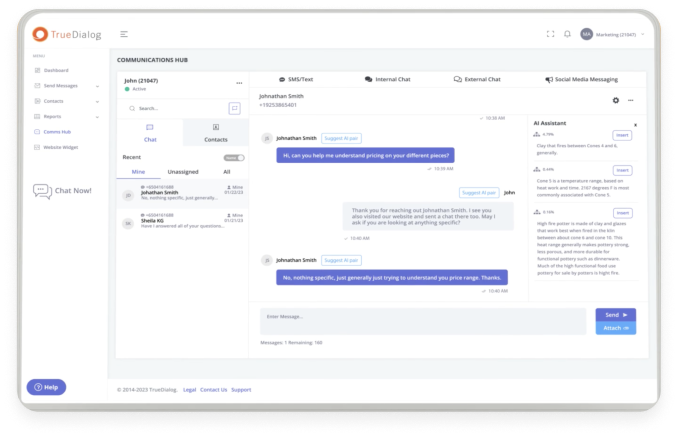Love it or hate it, we’re in an era of constant connection. Smartphones, smartwatches, Bluetooth-connected cars, WiFi on airplanes and city parks… We’re more plugged in than ever before, making how to get a text code for your business all the more valuable.
The availability of people and information has made life easier in many ways. What we need is at our finger (thumb) tips at virtually any given moment. It has also led to shortened attention spans and an overload of input from all angles.
Passive marketing is not as effective as it once was, and businesses can no longer rely upon having a great product to retain customers. Organizations that want to thrive in the modern era need to reach their customers in new ways and add value to build loyalty. That’s where SMS – and a text short code – comes in.
Nearly half of consumers polled said their preferred channel for brand updates was SMS. Not only are your customers open to receiving your messages, but they’re asking for it: the average American checks their phones 96 times per day, and SMS has an open rate of 98%. Compare that to just 20% of emails, and it’s apparent where to spend your time and effort. Get a text short code and open a new world of possibilities.
Get a Text Short Code in 3 Steps
Are you wondering how to get a text short code and get started with reaching your customers in new ways? If you’re ready to incorporate SMS into your marketing strategy and modernize your approach, it takes only a few short steps.
Sign Up with an SMS Platform Provider
Technically, you could go through the process yourself, though it’s not recommended. The process is lengthy and involves piles of legal paperwork. Businesses who opt to take care of things on their own spend a lot of time filling out forms and gathering paperwork often find that they missed something along the way.
Thankfully, there’s a better option. No one knows how to get a text short code like an SMS platform provider. You’ll need an SMS platform to help you craft, send, and track messages. It’s advisable to establish your relationship early in the process and let them handle the intricacies of leasing your text short code.
Lease a Short Code
When you get a cell phone or a landline, you don’t own your phone number. It belongs to you for the length of your contract, and when complete, the number will go to someone else. Effectively, you are leasing your phone number.
The same goes for short codes. Businesses never own their number outright and instead pay a fee to lease their number from the Short Code Registry. There are two ways to get a text short code: an automatically-generated number or a vanity short code.
A randomly selected short code carries a lower price tag. These numbers may or may not be memorable, depending on the luck of the draw.
On the other hand, Vanity short codes are specified by the business leasing them. If you’re a landscaper, you may request TREES (87337), for example. Vanity short codes are dependent upon availability and have a higher cost. They’re more memorable and easier to market to gain subscribers in exchange.
Start Texting
Getting a text short code takes a bit of time, but in about a month, you should be ready to get texting. While waiting, you can start to write your SMS strategy and determine how you’ll use business texting to your – and your customers’ – advantage.
To start, you’ll need to gain subscribers. To curb spam and harassment, businesses are legally barred from texting anyone who hasn’t first opted-in. Your SMS marketing strategy should get the word out and build your subscriber list.
Of course, you should be clear about what value you will add to those who subscribe. Some popular marketing uses for a text short code include:
- Promotions and discounts
- Announcements
- Order confirmation and tracking details
- Contests
- Event invitations
- Solicit feedback
- Reminders
SMS is timely and effective, reaching your audience where they’re (most likely) already looking. That makes a text short code a powerful tool for organizations. As they say, with great power comes great responsibility. Be careful not to spam your recipients, and ensure you follow through with your value-added commitments. Keep your messages short, sweet, and actionable, and you’ll build trust and brand loyalty.
Related: How to Send Out Mass Texts: A Guide for Businesses
Choose the Right Platform Provider
By now, you’ve realized that the SMS platform provider you choose plays a significant role in your business texting journey. It’s paramount to choose the right provider for you, to ensure you and your objectives are well supported.
Features of a Great SMS Platform
Your SMS platform provider is how you get a text short code, but so much more. With a variety of platforms to choose from, how do you ensure you select the right one?
Start by evaluating the features they offer, to ensure you have the best platform on your side.
Straightforward Interface
When it comes to adding a new tool to your organization, you may meet some resistance. More than that, your efforts to modernize may be to the detriment of the teams you rely on. The best way to curb that? Make sure you select a platform with a straightforward interface.
Features are great, but if your users find it challenging to navigate the application and take full advantage of them, you’ll reach a bottleneck. Your SMS platform should be feature-rich but user-friendly.
Not all of your users will be technically-minded, but that doesn’t mean they won’t be able to leverage your text short code’s capabilities. Similarly, your more technical employees will be able to take things to the next level. Select an SMS platform that caters to both the less tech-savvy and the tech gurus on your teams.
Integration Friendly
Adding new tools can feel like a risk. Training, onboarding, buy-in from employees, and the changes in workflows can create some pain points internally.
We’ve shown you how to get a text short code in an easy way, now it’s time to offer the same ease to your employees. Integrations are the key to easy implementation.
Integrating your SMS platform API into existing systems will make adoption smooth. If you’re using tools like Salesforce, Eloqua, or Microsoft Dynamics, your team members will be able to craft and send messages from within their existing platforms without ever toggling away.
Native integration makes using your text short code seamless. No need to learn new systems or adapt workflows – consider it a new feature to the tried-and-true ways of working. Your employees will be happy to hear that!
One- and Two-Way Communication Support
Once you get a text short code, you’ll need to start somewhere. For many businesses, that’s with one-way communication through marketing messages and alerts. Of course, as you build your subscriber list and gain experience in business SMS, you may wish to expand your communications.
Business texting is more than sending one-directional messages. You can also incorporate SMS into your customer service strategy. In fact, a reported 60% of consumers want to reach customer support using SMS.
Even if you’re not sure it’s in your future to receive two-way communications, it’s best to select an SMS platform provider that allows you the option. Don’t limit yourself – and your organization – by implementing a platform that can’t grow with you.
Scalable
Features and approaches aren’t the only way you’ll need to scale. As you gain subscribers, your volume of texts will grow. Get a text short code, share it, add value, and see your distribution list grow.
Ensure you select an SMS provider who can scale with you. Choose someone who can scale as your marketing and support approach does, and that can handle sending and receiving a high volume of texts.
Related: Maximize Your Marketing Strategy: SMS Marketing Best Practices
Free Trial
To ensure your SMS platform is right for you, start with a free trial. A quality platform provider will be happy to give you hands-on experience with their tool, helping you learn the ins and outs of texting for business. You’ll have an excellent opportunity to see what is available to you and ask questions.
TrueDialog has all of these features and more. Our expert team will support you with a free trial, how to get a text short code, and getting started with sending texts to your subscribers so you can thrive in this era with a modernized communication strategy.





